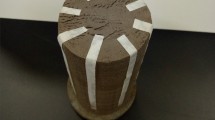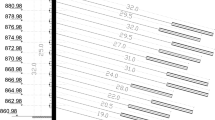Abstract
Due to the rapid growth of businesses and the population in Phnom Penh City, Cambodia, deep excavations for underground spaces are an economic necessity for landscape aspects. Several studies have been conducted on deep excavation and constitutive soil models in numerous Southeast Asian countries. However, there is limited information regarding (little knowledge available on) soil characteristics and subsurface conditions for excavation projects in Cambodia. This study uses 3D finite element analysis (FEA) to model a contiguous bore pile excavation with a bottom-up construction method located in Phnom Penh City sedimentary deposit. Site investigation, including field and laboratory tests, was conducted. Phnom Penh subsoils of the study location were modelled by Mohr–Coulomb, hardening soil and soft soil models. The model parameters were calibrated against triaxial and oedometer tests at the site. The 3D FEA were simulated to determine the lateral wall movement and ground surface settlement by comparing with the field monitoring data and empirical predictions. In Phnom Penh City, the clay layer mainly consists of three types of clay: medium clay, soft clay, and stiff clay. This exhibit is similar to alluvial deposits reported in other Southeast Asian cities. Based on the results of the analysis, the numerical simulation findings from various soil models are consistent with inclinometer data and empirical predictions. The simulations employing the hardening soil model show better results than those using the Mohr–Coulomb and soft soil models.












Similar content being viewed by others
Data availability
The data that support the findings of this study are available from the corresponding author upon reasonable request.
References
Zhang H-B, Chen J-J, Zhao X-S, Wang J-H, Hu H (2015) Displacement performance and simple prediction for deep excavations supported by contiguous bored pile walls in soft clay. J Aerosp Eng 28(6):A4014008
Hsiung B-CB, Yang K-H, Aila W, Hung C (2016) Three-dimensional effects of a deep excavation on wall deflections in loose to medium dense sands. Comput Geotech 80:138–151
Likitlersuang S, Surarak C, Wanatowski D, Oh E, Balasubramaniam A (2013) Finite element analysis of a deep excavation: a case study from the Bangkok MRT. Soils Found 53(5):756–773
Chheng C, Likitlersuang S (2018) Underground excavation behaviour in Bangkok using three-dimensional finite element method. Comput Geotech 95:68–81
Hsiung B-CB, Yang K-H, Aila W, Ge L (2018) Evaluation of the wall deflections of a deep excavation in Central Jakarta using three-dimensional modeling. Tunn Undergr Space Technol 72:84–96
Likitlersuang S, Chheng C, Keawsawasvong S (2019) Structural modelling in finite element analysis of deep excavation. J GeoEng 14(3):121–128
Padmanabhan G, Sasikala G, Ravisankar A (2018) Efficacy of engineered backfilling in limiting settlements during future deep excavations. Int J Geosynth Ground Eng 4:1–11
Tamura T, Saito Y, Sieng S, Ben B, Kong M, Choup S et al (2007) Depositional facies and radiocarbon ages of a drill core from the Mekong River lowland near Phnom Penh, Cambodia: evidence for tidal sedimentation at the time of Holocene maximum flooding. J Asian Earth Sci 29(5–6):585–592
Touch S, Likitlersuang S, Pipatpongsa T (2014) 3D geological modelling and geotechnical characteristics of Phnom Penh subsoils in Cambodia. Eng Geol 178:58–69
Hung NK, Phienwej N (2016) Practice and experience in deep excavations in soft soil of Ho Chi Minh City, Vietnam. KSCE J Civ Eng 20:2221–2234
Nguyen TS, Likitlersuang S (2021) Influence of the spatial variability of soil shear strength on deep excavation: a case study of a Bangkok underground MRT station. Int J Geomech 21(2):04020248
Nguyen TS, Phan TN, Likitlersuang S, Bergado DT (2022) Characterization of stationary and nonstationary random fields with different copulas on undrained shear strength of soils: probabilistic analysis of embankment stability on soft ground. Int J Geomech 22(7):04022109
Ou C-Y, Chiou D-C, Wu T-S (1996) Three-dimensional finite element analysis of deep excavations. J Geotech Eng 122(5):337–345
Hsiung B-CB, Likitlersuang S, Phan KH, Pisitsopon P (2021) Impacts of the plane strain ratio on excavations in soft alluvium deposits. Acta Geotech 16:1923–1938
Goh A, Zhang F, Zhang W, Zhang Y, Liu H (2017) A simple estimation model for 3D braced excavation wall deflection. Comput Geotech 83:106–113
Puzrin AM, Alonso EE, Pinyol N, Puzrin A, Alonso E, Pinyol N (2010) Braced excavation collapse: Nicoll Highway, Singapore. In: Geomechanics of failures, pp 151–181
Chen R, Li Z, Chen Y, Ou C, Hu Q, Rao M (2015) Failure investigation at a collapsed deep excavation in very sensitive organic soft clay. J Perform Constr Facil 29(3):04014078
Likitlersuang S, Surarak C, Suwansawat S, Wanatowski D, Oh E, Balasubramaniam A (2014) Simplified finite-element modelling for tunnelling-induced settlements. Geotech Res 1(4):133–152
Surarak C, Likitlersuang S, Wanatowski D, Balasubramaniam A, Oh E, Guan H (2012) Stiffness and strength parameters for hardening soil model of soft and stiff Bangkok clays. Soils Found 52(4):682–697
Likitlersuang S, Teachavorasinskun S, Surarak C, Oh E, Balasubramaniam A (2013) Small strain stiffness and stiffness degradation curve of Bangkok Clays. Soils Found 53(4):498–509
Yang Y, Chen C, Liu C, Huang L, Chen W, Lin N et al (2023) Performance of a deep excavation and the influence on adjacent piles: A case history in karst region covered by clay and sand. Undergr Space 8:45–60
Yang X, Jia M, Ye J (2020) Method for estimating wall deflection of narrow excavations in clay. Comput Geotech 117:103224
Chai J, Ni J, Ding W, Qiao Y, Lu X (2021) Deep excavation in under-consolidated clayey deposit. Undergr Space 6(4):455–468
Muenpetch N, Keawsawasvong S, Komolvilas V, Likitlersuang S (2023) Numerical investigation on impact of excavations in influence zone of existing MRT tunnels. In: Geomechanics and geoengineering, pp 1–20
Huynh QT, Lai VQ, Boonyatee T, Keawsawasvong S (2022) Verification of soil parameters of hardening soil model with small-strain stiffness for deep excavations in medium dense sand in Ho Chi Minh City, Vietnam. Innov Infrastruct Solut 7(1):15
Huynh QT, Lai VQ, Shiau J, Keawsawasvong S, Mase LZ, Tra HT (2022) On the use of both diaphragm and secant pile walls for a basement upgrade project in Vietnam. Innov Infrastruct Solut 7(1):17
Brinkgreve R, Kumarswamy S, Swolfs W, Waterman D, Chesaru A, Bonnier P (2016) PLAXIS 2016. PLAXIS bv, The Netherlands
Likitlersuang S, Surarak C, Wanatowski D, Oh E, Balasubramaniam A (2013) Geotechnical parameters from pressuremeter tests for MRT Blue Line Extension in Bangkok. Geomech Eng 5(2):99–118
Nguyen TS, Ngamcharoen K, Likitlersuang S (2023) Statistical characterisation of the geotechnical properties of Bangkok subsoil. Geotech Geol Eng 41(3):2043–2063
Hsiung B-CB (2009) A case study on the behaviour of a deep excavation in sand. Comput Geotech 36(4):665–675
Japan AIo (2001) Recommendations of design of building. Japanese
ASTM-D4767 (2020) Standard test method for consolidation-undrained triaxial compression test on cohesive soil
ASTM-D4767/D4186M (2020) Standard test method for one-dimensional consolidation properties of saturated cohesive soils using controlled-strain loading
Sukkarak R, Likitlersuang S, Jongpradist P, Jamsawang P (2021) Strength and stiffness parameters for hardening soil model of rockfill materials. Soils Found 61(6):1597–1614
Wang J, Xu Z, Wang W (2010) Wall and ground movements due to deep excavations in Shanghai soft soils. J Geotech Geoenviron Eng 136(7):985–994
Hashash YM, Whittle AJ (1996) Ground movement prediction for deep excavations in soft clay. J Geotech Eng 122(6):474–486
Roboski J, Finno RJ (2006) Distributions of ground movements parallel to deep excavations in clay. Can Geotech J 43(1):43–58
Hsieh P-G, Ou C-Y (1998) Shape of ground surface settlement profiles caused by excavation. Can Geotech J 35(6):1004–1017
Ng CW, Simpson B, Lings ML, Nash DF (1998) Numerical analysis of a multipropped excavation in stiff clay. Can Geotech J 35(1):115–130
Hou Y, Wang J, Zhang L (2009) Finite-element modeling of a complex deep excavation in Shanghai. Acta Geotech 4:7–16
Ou C-Y, Hsieh P-G, Chiou D-C (1993) Characteristics of ground surface settlement during excavation. Can Geotech J 30(5):758–767
Lim A, Ou C-Y (2017) Stress paths in deep excavations under undrained conditions and its influence on deformation analysis. Tunn Undergr Space Technol 63:118–132
Schweiger H (2010) Design of deep excavations with FEM-Influence of constitutive model and comparison of EC7 design approaches. In: Earth retention conference, vol 3, pp 804–817
Lim A, Ou C-Y, Hsieh P-G (2020) A novel strut-free retaining wall system for deep excavation in soft clay: numerical study. Acta Geotech 15:1557–1576
Ahmadi A, Ahmadi MM (2022) Three-dimensional numerical analysis of corner effect of an excavation supported by ground anchors. Int J Geotech Eng 16(7):903–915
Abbas Q, Yoon J, Lee J (2023) Characterization of wall deflection and ground settlement for irregular-shaped excavations with changes in corner configuration. Int J Geomech 23(1):04022258
Petchkaew P, Keawsawasvong S, Tanapalungkorn W, Likitlersuang S (2023) 3D stability analysis of unsupported rectangular excavation under pseudo-static seismic body force. Geomech Geoeng 18(3):175–192
Petchkaew P, Keawsawasvong S, Tanapalungkorn W, Likitlersuang S (2023) Seismic stability of unsupported vertical circular excavations in c–φ soil. Transport Infrastruct Geotechnol 10(2):165–179
Acknowledgements
This research was supported by the Thailand Science research and Innovation Fund Chulalongkorn University (No. 6641/2566). This research was also funded by King Mongkut’s University of Technology North Bangkok, under Contract No. KMUTNB-66-BASIC-06. The first author (D. Roeun) acknowledges the Graduate Scholarship Programme for ASEAN or Non-ASEAN countries from Chulalongkorn University. The authors would like to thank Dr. Ritthy Ouch for providing the data in this study.
Author information
Authors and Affiliations
Contributions
Daro Roeun: formal analysis, investigation, data curation, writing—original draft, and visualisation. Raksiri Sukkarak: methodology, software, validation, and writing—review and editing. Suched Likitlersuang: conceptualization, resources, writing—review and editing, supervision, project administration, and funding acquisition.
Corresponding author
Ethics declarations
Conflict of Interest
On behalf of all authors, the corresponding author states that there is no conflict of interest.
Additional information
Publisher's Note
Springer Nature remains neutral with regard to jurisdictional claims in published maps and institutional affiliations.
Rights and permissions
Springer Nature or its licensor (e.g. a society or other partner) holds exclusive rights to this article under a publishing agreement with the author(s) or other rightsholder(s); author self-archiving of the accepted manuscript version of this article is solely governed by the terms of such publishing agreement and applicable law.
About this article
Cite this article
Roeun, D., Sukkarak, R. & Likitlersuang, S. Influences of Subsoil Modelling on Underground Deep Excavation Behaviour in Phnom Penh City, Cambodia. Int. J. of Geosynth. and Ground Eng. 10, 27 (2024). https://doi.org/10.1007/s40891-024-00534-6
Received:
Accepted:
Published:
DOI: https://doi.org/10.1007/s40891-024-00534-6




